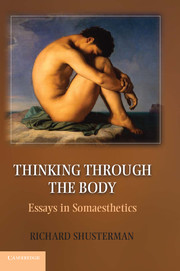Book contents
- Frontmatter
- Contents
- Preface
- Introduction
- Part I Somatic Being, Knowing, and Teaching
- Part II Somaesthetics, Aesthetics, and Culture
- 6 Somaesthetics and the Limits of Aesthetics
- 7 Somaesthetics and Burke's Sublime
- 8 Pragmatism and Cultural Politics
- 9 Body Consciousness and Performance
- Part III The Arts and the Art of Living
- Select Bibliography
- Index
- References
6 - Somaesthetics and the Limits of Aesthetics
Published online by Cambridge University Press: 05 November 2012
- Frontmatter
- Contents
- Preface
- Introduction
- Part I Somatic Being, Knowing, and Teaching
- Part II Somaesthetics, Aesthetics, and Culture
- 6 Somaesthetics and the Limits of Aesthetics
- 7 Somaesthetics and Burke's Sublime
- 8 Pragmatism and Cultural Politics
- 9 Body Consciousness and Performance
- Part III The Arts and the Art of Living
- Select Bibliography
- Index
- References
Summary
I
What is the origin of somaesthetics? Like most cultural products and research projects, somaesthetics has multiple roots and generative influences. It was engendered not only from a vast variety of philosophical ideas but through the inspiration of somatic therapies and other body disciplines, as well as more general influences in contemporary culture. The full genealogy of somaesthetics would thus present a complex task of historical analysis, too complex to undertake here. However, as the individual who initially conceived and coined the project of somaesthetics, I should provide an account of how I came to propose this field of inquiry. In tracing how somaesthetics emerged from my struggle with the limits of philosophical aesthetics, this chapter also seeks to demonstrate how the struggle with limits is not a purely idiosyncratic matter, but rather a struggle that somehow pervades and structures the field of aesthetics. My personal philosophical trajectory from analytic philosophy of art to somaesthetics can thus help illuminate more generally the structure and limits of the aesthetic field.
Reviewing my almost thirty-year career in philosophical aesthetics, I realize that much of it has been a struggle with the limits that define this field, although I did not always see it in those terms. When I was still a student at Oxford specializing in analytic aesthetics, my first publications were papers protesting the limits of prevailing monistic doctrines in the philosophy of literature: theories claiming that poetry (and by extension, literature in general) is essentially an oral-based performative art without real visual import; and theories arguing that beneath the varying interpretations and evaluations of works of art there was nonetheless only one basic logic of interpretation and one basic logic of evaluation (though philosophers differed as to what that basic logic was and whether it was the same for both interpretation and evaluation). When I proposed contrastingly pluralistic accounts of interpretive and evaluative logic, while suggesting that literature could be appreciated in terms of sight as well as sound, I was not consciously aiming at transgressing the prevailing limits. I was more interested in being right than in being different or original, and I saw myself as working fully within the limits of analytic aesthetics.
- Type
- Chapter
- Information
- Thinking through the BodyEssays in Somaesthetics, pp. 125 - 144Publisher: Cambridge University PressPrint publication year: 2012



